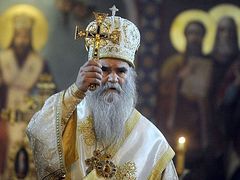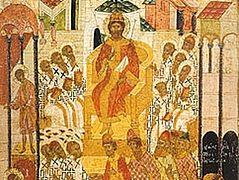The recent initiative of the Patriarchate of Constantinople to “legalise” the schismatic jurisdictions in Ukraine did not create a particularly new problem, but it did stir some of the unresolved ecclesiological issues into a new tornado of communiqués of the official authority structures in the Church. In turn the Orthodox academic milieu reacted with a series of re-examinations of the popular matters such as jurisdictional boundaries, overlapping jurisdictions in the so-called Diaspora, primacy, the right to recognise autocephaly, etc. which are not a complete novelty for the Church in the 21st century. However, there is one question that seems to be neglected by all sides, and that is the issue of the method of (re)establishing unity with the schismatic pseudo-Orthodox groups, like the Ukrainian jurisdictions in this matter, but not limited to them. The method in this context is not pertaining to the canonicity of the Phanar actions; moreover setting all the above mentioned issues aside, one must wonder if this is the first time that the Church is trying to re-establish the unity with certain groups? If it is not, let’s marvel then at the method used by the Fathers in such circumstances in order to learn a lesson for the future.
Two types of schisms
Schisms of dogmatic nature, or those that separated from the One, Holy, Catholic and Apostolic Church exclusively on the matter of doctrine, such as Arians, were mended with certain ease. The canons of the Ecumenical Councils facilitated for their reconciliation with the Church through the acceptance of the Orthodox faith and in some cases even baptism1. Some were permanently removed from the priesthood but others could even continue to serve as ordained clergy, depending on the kind of schism in which they took part. However, their return was never arranged as a negotiation of two equals, but exclusively as the reconciliation of the lapsed with the Church.
Divisions are painful for the Church, especially when they appear over earthly, non-theological, even political issues. The most common of such matters are (ethno)phyletism and ecumenism. Two sides of the same coin, eloquently described by Father Peter Heers as: “Far from being enemies or correctives of each other, ecumenism and phyletism are rather two sides of the same coin of secularism. Both deny the catholicity of the One Church and both seek to recognise in its place a “divided” Church, whether it be along ethnic or denominational lines.”2 Even though both ecumenism and phyletism are relatively new phenomenon, secular interference with Church issues is as old as the “legalisation” of Christianity.
One of the earliest and certainly most famous divisions that happened as a direct consequence of the secular influences (phyletism) was the Chalcedonian controversy in the fifth century. The Great Schism in the XI century can probably be traced to significant secular influences (Charlemagne) as the original instigators as well. The problem of the calendar reform in the early XX century, and nationalistic uprisings such as in Ukraine, Montenegro, or Croatia, towards the end of the same century belong exclusively to the area of secular influences (ecumenism and phyletism, respectively). Furthermore, the case of the non-canonical Macedonian Orthodox Church was probably the only example in history where ecclesial independence was prompted by an officially atheist secular regime of Yugoslavia. This example is rivalled only by the present case of the non-canonical Ukrainian Church, where issue of independence is initiated by an officially secular regime of Ukraine.
Two methods of reconciliation
History demonstrates that these secular schisms remain unhealed to this day. The impractical attempt of Constantinople to resolve the Ukrainian issue without the Moscow Patriarchate evidently can achieve nothing else but deepen the schism and make things worse. The principal reason for this trend of inefficiency is the fact that the Church is not evoking the experience of the Fathers to receive back those that came to themselves (Lk 15:17) but is rather using a modern, secular, and predominantly ecumenist method of political compromise.
The secular ecumenist method implies, at least in some degree, the acceptance of the “Branch theory”, which is undoubtedly an ecclesiological heresy. Hence, this is a very problematic point for the Church. In order to negotiate with the schismatic groups as with an equal partner to the Church, in terms of legal entities, one is forced to overlook the fact that there is no other way back but through metanoia. For the modern secular powers, obviously involved in the process, this is a politically incorrect practice. It seems that certain Orthodox ecclesial authority structures are so accustomed to secular, politically correct methods, that they became their principal mode of operation3.
However, in order to achieve compromise it is necessary for all involved parties to reach the lowest common denominator. This might be a very civilised way of overcoming social and political differences but in matters of faith this method can be extremely dangerous. The Church is called to strive up not down, to pull the world towards God not to descend to “lowest common denominators”. For the Fathers, not even the Orthodox faith was enough for a compromise with schismatics. Unfortunately, it seems that the modern authority structures of the Church are more willing to adopt an ecumenist method of compromise, as seen in the World Council of Churches, then the Traditional approach of the Fathers.
Even H.E. John Zizioualas, one of the greatest Orthodox champions of the ecumenical movement, is advocating the same in his reflection on the official dialogue with the non-Chalcedonians,4 saying that the state of schism is much more severe than simple disagreement on doctrine. This is why in the introduction of this article all schismatic groups were labelled as “pseudo-Orthodox”. For as long as they are not in the Eucharistic communion with the Church, no matter how genuinely Orthodox in doctrine, how conservative socially, or how ethical they may be, they simply are not Orthodox. This is probably the “lowest common denominator” for all in the canonical Orthodox Church, but also the point of divergence when it comes to method of overcoming this challenge. Clearly the Patriarchate of Constantinople in the case of Ukraine, as other jurisdictions do in other similar matters, treat the dialogue with the schismatic Orthodox groups as a political strategy of the ecumenism on the right wing.
One pastoral solution
This strategy comes down to legalisation of schismatics through mere economia in order to gain certain worldly, material and political, or simply- secular goals. That is precisely why it is important to uphold the belief that unity of the Church is exclusively a matter of unity with Christ in the Sacraments of the Church. Secret ordinations outside of liturgical communities, simple acceptances of the returned clerics with unchanged hearts and worldly compromises are of no other value but superficial aesthetics. Furthermore, this practice extinguishes the fear of God as not only individual priests (who are a common site in the so-called Orthodox diaspora) but whole jurisdictions are encouraged to leave the Church whenever they might seem opportune, and then negotiate their return through another canonical jurisdiction. This practice was outlawed back in the First Ecumenical Council (Canon V) and yet it seems so common these days that it is about to escalate to an unprecedented level.
At the same time this should not mean that the Church must become a court of law without compassion and consideration. No one suggests that the Church should be self-involved, without care for those that are outside of her embrace. The Church is obliged by its nature and mission to be in constant and genuine dialogue with those that are on the outside. Genuine dialogue is achieved when both parties are speaking but also listening. In this dialogue the Church should listen for the call: “Father, I have sinned against heaven and before you; I am no longer worthy to be called your son.” (Lk, 15:21) and then speak the truth in love (that) we are to grow up in every way into him who is the head, into Christ (Eph, 4:15). The only way to heal a schism is for the lapsed to be reconciled with Christ through the Church.
Fr. Nemanja Mrdjenovic is a Serbian Orthodox priest from Sydney, Australia. Faculty member of Ss Cyril and Methodius Orthodox Institute (ACD). Vice-director of Centre for Study of Orthodox Monarchism from Belgrade, Serbia.





